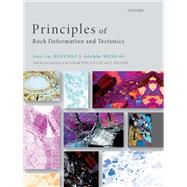- ISBN: 9780192843876 | 0192843877
- Cover: Hardcover
- Copyright: 10/31/2021
Jean-Luc Bouchez, Toulouse University,Adolphe Nicolas, Montpellier University
Professor Jean-Luc Bouchez (1946-)
After his academic studies at Grenoble University (France) in Physics and Earth Science, Jean-Luc Bouchez became assistant professor at Nantes University (France) under the direction of Adolphe Nicolas until 1986. He then attended the Observatoire Midi-Pyr?n?es (Toulouse University), doing teaching
and research worldwide (Africa, Brazil, Iran, Spain, Portugal ...) concerning principally mineral and magnetic fabrics, natural plasticity of quartz-rich rocks, and emplacement of granite plutons. He was awarded the Louis Barrab? Medal at the French Geological Society.
Professor Adolphe Nicolas (1936-2020)
After his academic studies at University of Paris in Physics and Earth Sciences, he became assistant professor at the School of Mines in Nancy (France), then professor, first at the University of Nantes, up to 1986, where he set up his Petrophysics Laboratory, which then moved to Montpellier
University. He was a specialist of peridotites and ophiolites, particularly from Oman. Adolphe Nicolas wrote several books, among which "Principes de Tectonique" (1984), and was awarded several distinctions: Fellow of the American Geophysical Union (AGU); Veinig Meinez Medalist; Member of The
Institut Universitaire de France; Dolomieu Award of the French Academy of Sciences; Harry Hess Medal of the AGU.
Forewords and Acknowledgements
1 Deformation/strain and stress
1.1. Deformation / strain
1.2. Stress
1.3. Stress-strain relationships
2 Brittle deformation
2.1. Fracture modes
2.2. Coulomb's law of failure and the Mohr fracture envelope
2.3. Rupture under different conditions
2.4. In-situ stress measurements
2.5. The brittle-ductile transition
3. Brittle deformation structures
3.1. Joint, fissure, cleavage and barren fracture
3.2. Tension fractures
3.3. Faults
3.4. Dynamic analysis of faults
4. Ductile deformation and microstructures
4.1. Cataclastic deformation and granular materials
4.2. Plasticity due to movement of dislocation
4.3. Solid state diffusion flow
4.4. Fluid-assisted flow mechanisms
4.5. Localization of deformation and shear zones
4.6. A few distinctive microstructures
4.7. (T, s, e') deformation maps
5 Macroscopic imprints of ductile deformation
5.1. A few notions about folds
5.2. Planar structures
5.3. Linear structures
5.4. Relationships between lineations, fold-axes and strain ellipsoids
5.5. Terminology conventions
6. Fabrics and kinematic analysis of quartzites, ice and peridotites
6.1. Development of preferred orientations
6.2. Coaxial and non-coaxial lattice fabrics
6.3. Fabric representation: the orientation diagram
6.4. Fabrics and kinematic analysis
6.5. Examples of fabrics
6.6. Past and present mantle flow
7 Magmatic fabrics, structures and microstructures
7.1. Some rheological aspects
7.2. Microstructures: magmatic, orthogneissic and mylonitic
7.3. Magmatic fabric acquisition in plutons
7.4. Magmatic fabrics in plutons
7.5. Injections in magmatic complexes: mixing and mingling
7.6. The Bushveld and Skaergaard mafic complexes
7.7. Gabbros from the oceanic crust
8 Rheology of the lithosphere and states of stress
8.1. Rheological profile of the lithosphere: the Christmas tree
8.2. Mechanical anisotropy of the lithosphere
8.3. Focal mechanisms of earthquakes
8.4. Stress concentration
8.5. From the stress bulb to the Indian indenter
8.6. States of stress in France and around the World
9 Horizontal / vertical displacements and their rates
9.1. Horizontal displacements and rates
9.2. Vertical displacements
10. Technical aspects of tectonics
10.1. Tensorial representation of deformation
10.2. Tensorial representation of stress
10.3. W?lff and Schmidt nets
10.4. The universal stage
10.5. The texture goniometer
10.6. The EBSD technique
10.7. Digital images and shape preferred orientations (SPO)
10.8. Anisotropy of magnetic susceptibility (AMS)
10.9. Gravimetric analysis
11. Practical exercises
11.1. Application of Mohr diagram in structural geology
11.2. Internal inclusions in garnets
11.3. Introduction to orientation diagrams
11.4. Fold-axis construction : an example from the field
11.5. Unravelling structure entanglements
11.6. Looking for past states of stress: paleostress analysis
11.7. Looking for successive states of stress in the Lefkas region (Greece)
11.8. Looking for a local state of stress
11.9. Isostasy, the very base of vertical movements
Index
The New copy of this book will include any supplemental materials advertised. Please check the title of the book to determine if it should include any access cards, study guides, lab manuals, CDs, etc.
The Used, Rental and eBook copies of this book are not guaranteed to include any supplemental materials. Typically, only the book itself is included. This is true even if the title states it includes any access cards, study guides, lab manuals, CDs, etc.
Digital License
You are licensing a digital product for a set duration. Durations are set forth in the product description, with "Lifetime" typically meaning five (5) years of online access and permanent download to a supported device. All licenses are non-transferable.
More details can be found here.






